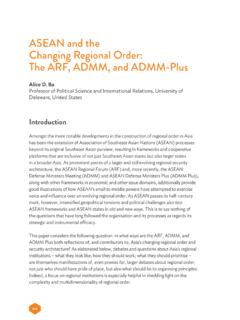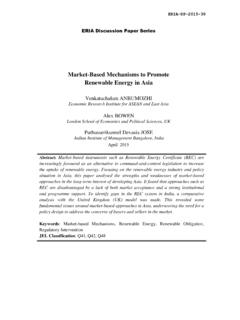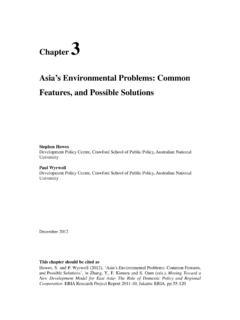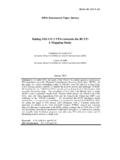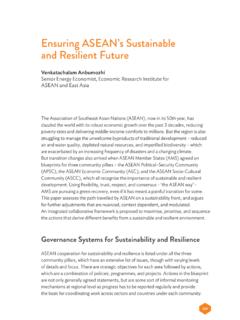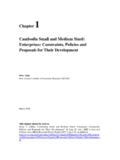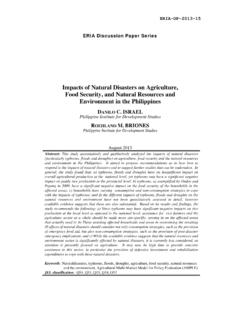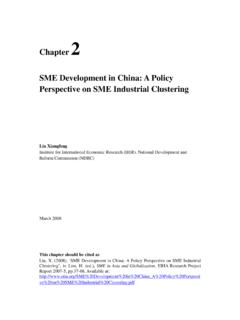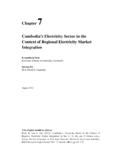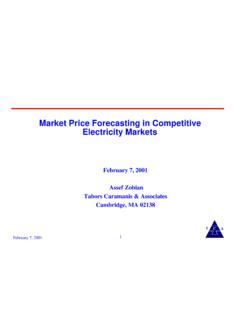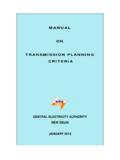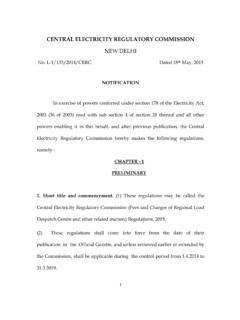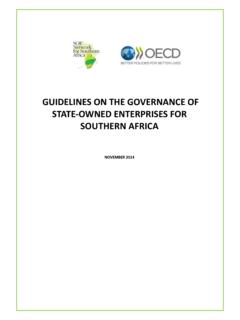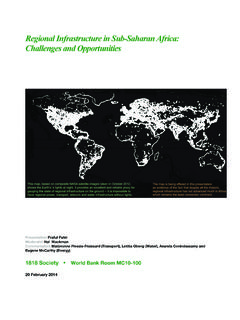Transcription of Study on the Impacts of Electricity Tariff Increase on the ...
1 Chapter 10. Study on the Impacts of Electricity Tariff Increase on the National Economy of Vietnam Nguyen Quoc Khanh Independent Researcher August 2012. This chapter should be cited as Nguyen, Q. K. (2012), Cambodia's Electricity Sector in the Context of Regional Electricity Market Integration' in Wu, Y., X. Shi, and F. Kimura (eds.), Energy Market Integration in East Asia: Theories, Electricity Sector and Subsidies, ERIA. Research Project Report 2011-17, Jakarta: ERIA, CHAPTER 10. Study on the impact of Electricity Tariff Increase on the National Economy of Vietnam NGUYEN QUOC KHANH. Independent Consultant The Electricity price in Vietnam in 2011 was around 6 US /kWh which is lower than the Long Run Marginal Cost (LRMC) of US /kWh. This low price discourages energy productivity enhancement and affects energy supply security. Thus, the Government of Vietnam plans to Increase the Electricity Tariff .
2 This Study examines the Impacts of increasing Electricity Tariff to the LRMC on prices of consumer goods and services and the likely distribution Impacts by household income quintiles using a static Input-Output approach. The Study found that such an Increase would drive up the prices of all other products. The price impact , however, is not large. The distribution impact by household income quintiles is also not large. Although the impact is not large, it would be socially difficult to implement this Increase at once, particularly given that Vietnam is facing high inflation rates. A roadmap for Electricity Tariff Increase is thus discussed. 253. 1. Background Vietnam's high economic growth rate has led to increasing demand for Electricity . Between 2001 and 2010, Electricity production (including imported Electricity ) increased from billion kWh to 100 billion kWh; Electricity sales from billion kWh to billion kWh and installed capacity from 7,872 MW to 21,542 MW, reaching an average annual growth rate of , and 12%, respectively.
3 Generation mix in 2010 was gas fired power plants 41%, hydro power plants , coal fired power plants 11% and the rest are oil, renewables and import from China. As an emerging economy, Electricity demand is expected to keep growing significantly in the forthcoming period, 2010 2030. The Power Development Plan No. 7 forecasted that Electricity demand would Increase from 100. billion kWh in 2010 to 695 billion kWh by 2030, at an average annual growth rate of 10% per year (PM, 2011b). Vietnam is expected to become a net energy importer by around 2015. Such rapid development raises a number of questions for the Government of Vietnam, including (i) how to secure funds to finance such an aggressive power source development, and then (ii) how to manage the power sector effectively and efficiently. Currently, the power sector of Vietnam is dominated by the Electricity of Vietnam (EVN), a government-owned utility.
4 EVN has a majority in generation capacity (around 65% in 2010), and a monopoly role in transmission and sales of Electricity . Electricity retail Tariff in Vietnam is governed by the Government, and the Government of Vietnam maintains uniform national Electricity Tariff across the country which is highly subsidized. The weighted average retail Electricity Tariff in Vietnam in 2011 was only US /kWh while the Long Run Marginal Cost (LRMC) was US /kWh. The subsidy amount in 2010 was estimated at billion USD, equivalent to of GDP in the same year (IEA, 2011). EVN's revenue in 2010 was around USD billion while the required investment capital is estimated at between USD 6-7 billion per year over 2011-2030. 254. To address these challenges the Government of Vietnam plans to restructure the power sector. The roadmap which has been approved by the Prime Minister specifies that the power market in Vietnam will be established through three sequential developments: competitive generation power market, competitive wholesale power market and competitive retail power market.
5 Phase I starts in 2009, phase II in 2017 and phase III in 2024 (PM, 2006). To do this, however, the Electricity retail Tariff to users, and subsequently the purchasing price for power from power producers, must first be increased. This is because the weighted average retail Electricity Tariff in Vietnam was generally lower than that of most countries (for example, the Electricity price in Thailand in 2011 was US /kWh) (ADB, 2012b) and, therefore, not attractive for local and foreign enterprises to invest in new generating capacity in Vietnam. This situation is also unfavorable for Vietnam with regard to the promoted plan of regional power interconnection grid (for example, the Electricity imported from China is currently paid at a higher level than the purchasing price to power producers). This problem has been recognized by the Government of Vietnam.
6 As a response, the Government of Vietnam plans to Increase the Electricity Tariff to reflect the production cost to improve energy supply security and to improve energy productivity (PM, 2009 and PM, 2011a). This action will definitely have Impacts on other sectors, on macroeconomic indicators and social welfare. In this Study , we examine two broad questions: First, what would be the Impacts of rising Electricity Tariff on prices of other sectors of the economy? In connection with this question, Electricity intensity of various sectors will be first explored. Second, what are the likely distributional Impacts induced by this price rise? To answer the above questions this paper presents the methodology used to examine the Impacts of Electricity price Increase on other sectors in Section 2. Section 3 discusses the results and Section 4 considers some policy recommendations.
7 255. 2. Methodology and Data Preparation Because Electricity is used as inputs to produce most of the goods and services, a higher Electricity price can affect the prices of other sectors of an economy both directly and indirectly. The I O model describes the interdependence of all sectors in the production and consumption of products. It shows the input requirement for a sector and at the same time specifies how that sector distributes its production output to other sectors. In this regard, the I O model is able to analyze the relationships among sectors, evaluate the Impacts from one sector to other sectors, and can thus be used to quantify the effects from the Electricity sector. The I O model was first proposed by Leontief in 1936. Since then it has been applied to various areas. It has also been widely applied in energy-related contexts including Electricity .
8 Using the I O model, Pfaffenberger, et al. (2003) examined the Impacts from the development of renewable energy technologies such as wind turbine and solar photovoltaic on the economy of Germany in terms of creating job. Tiwari (2000) used I-O modelling to estimate energy intensities of different sectors in India. Similarly, Pachauri & Spreng (2006) also used the I O model to determine the indirect energy requirements of Indian households. Hadley, et al. (2001). examined the Impacts from the restructuring of the power sector on Oklahoma in the USA. The I O model has been introduced at some universities in Vietnam since the mid-1960s (Dong, et al. 2006). However, it was not until 1989 that the first national I O table of 54 sectors was made. To date, four national I O tables have been created. The latest table consists of 138 sectors for 2007 and was released in 2010.
9 There have been several studies applying these I O tables. For example, Bo (2002). applied the I O table to examine the role of the construction sector in the national economy. Tuyet & Ishihara (2006) used the I O tables of 1996 and 2000 to examine the changes in energy intensities of different sectors between 1996 and 2000. Recently, a research group from the National University of Economics has used the I-O table of 2005 to examine the Impacts of rising petroleum products on the economy (Thanh, et al. 2008). Khanh (2008) examined the impact of a rise in 256. Electricity Tariff on prices of consumer goods and services in Vietnam. There has, however, been no Study consisting of a complete and updated examination of the sectoral Impacts of Electricity prices in the Vietnamese economy. With salient features in impact investigation and related applications as described above, in this research, the I-O model is chosen to examine the Impacts from Electricity Tariff Increase on the prices of other sectors in Vietnam.
10 For this purpose, the following subsection will focus on the description of the I-O model and its adaptability to this specified task. The General Framework of I-O Model The I-Omodel is a set of linear equations, which represent the relationships among sectors of an economy over a stated period of time, say, a year. The I-O model for an economy consisting of n sectors can be expressed as n n X i X ij Fi aij X j Fi (1). j 1 j 1. or n n X j X ij V j rij X i V j (2). i 1 i 1. where Xi is the total gross output of sector i (i=1,..,n); aij, defined as the delivery from sector i to j (Xij) per unit of sector j's output (Xj) are known as direct input or technical coefficients; rij are direct output coefficients, obtained by dividing the purchase by sector i from sector j by Xi total gross input of sector i; Fi is final demand for sector i; and Vj is the value added in sector j.
